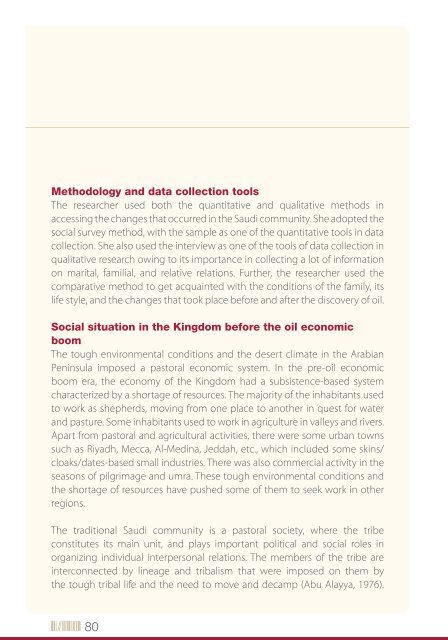General Supervisor
General Supervisor
General Supervisor
Create successful ePaper yourself
Turn your PDF publications into a flip-book with our unique Google optimized e-Paper software.
Methodology and data collection tools<br />
The researcher used both the quantitative and qualitative methods in<br />
accessing the changes that occurred in the Saudi community. She adopted the<br />
social survey method, with the sample as one of the quantitative tools in data<br />
collection. She also used the interview as one of the tools of data collection in<br />
qualitative research owing to its importance in collecting a lot of information<br />
on marital, familial, and relative relations. Further, the researcher used the<br />
comparative method to get acquainted with the conditions of the family, its<br />
life style, and the changes that took place before and after the discovery of oil.<br />
Social situation in the Kingdom before the oil economic<br />
boom<br />
The tough environmental conditions and the desert climate in the Arabian<br />
Peninsula imposed a pastoral economic system. In the pre-oil economic<br />
boom era, the economy of the Kingdom had a subsistence-based system<br />
characterized by a shortage of resources. The majority of the inhabitants used<br />
to work as shepherds, moving from one place to another in quest for water<br />
and pasture. Some inhabitants used to work in agriculture in valleys and rivers.<br />
Apart from pastoral and agricultural activities, there were some urban towns<br />
such as Riyadh, Mecca, Al-Medina, Jeddah, etc., which included some skins/<br />
cloaks/dates-based small industries. There was also commercial activity in the<br />
seasons of pilgrimage and umra. These tough environmental conditions and<br />
the shortage of resources have pushed some of them to seek work in other<br />
regions.<br />
The traditional Saudi community is a pastoral society, where the tribe<br />
constitutes its main unit, and plays important political and social roles in<br />
organizing individual interpersonal relations. The members of the tribe are<br />
interconnected by lineage and tribalism that were imposed on them by<br />
the tough tribal life and the need to move and decamp (Abu Alayya, 1976).<br />
80<br />
Al-hmoula (literally, cargo or load) is metaphorically a group of families<br />
interconnected by genealogical lineage, and having the same ethnic origin<br />
going back to up to five generations. For instance, people from some regions<br />
of the Kingdom such as the Najd area are determined to know the ethnic<br />
origin of an individual, and to protect them from mixing from other unknown<br />
ethnicities to them.<br />
The family in the traditional Saudi community<br />
The prevailing form of family in the traditional Saudi community is the extended<br />
family, which is made up of three or more generations, sometimes complexly<br />
formed. It includes a number of brothers, their children, and grandchildren.<br />
The members of the same family used to live in the same common multi-room<br />
house. Often than not, the members of the same nuclear family (husband and<br />
wife and their unmarried children) used to live in the same room. The size of<br />
the house varies depending on the various social and economic standards of<br />
the family (Al-Khateeb, 1981).<br />
Ownership in the traditional Saudi community is a collective ownership<br />
registered in the name of the whole family. The eldest man in the family is the<br />
absolute master in terms of decisions about the family’s properties. However,<br />
all have the right to benefit from this property, including land, date trees,<br />
agriculture, wells, cattle, etc.<br />
Marriage is the first step in family formation. The traditional Saudi community<br />
looks at marriage with respect and veneration. For that, fathers in all of the<br />
pastoral, rural, and urban regions used to insist on marrying their sons and<br />
daughters at an early age. According to the Saudi community, marriage is<br />
a rule of life, and a kind of protection for man and woman from deviation.<br />
The preferred marital age used to be 14 to 16 for girls and 16 to 18 for boys.<br />
Prearranged marriage was the prevailing type of marriage in the past, and often<br />
81


